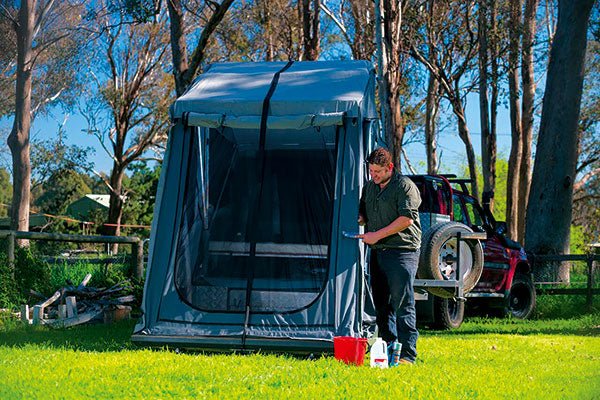
Camper canvas care
|
|
Time to read 4 min
|
|
Time to read 4 min
Nature can throw its fair share of challenges at the avid camper. I mean when you think about it, you could be subjected to anything from heavy rain to hail and freezing-cold snow to excessive heat, along with the more common oppresive humidity and strong wind. Now most camper trailers offer nothing more than a single layer of canvas between you and the elements outside – so you’d want to make sure it’s a bloody good layer, eh? Sure, good quality canvas will generally last a life time if it’s cared for correctly, but like everything else, canvas does wear down over time. It loses strength and durability, and may develop water leaks here and there. But that doesn’t mean you can’t keep it in tip-top shape as the years keep rolling by. In fact, by developing a few good habits, there’s no reason you couldn’t pass your old trusty canvas tent down to the grandchildren!
Ok, so let’s start with the obvious stuff, shall we? Mould and mildew are by far the biggest killers of most types of fabric, especially canvas. In fact, it’s the main reason you should never fold or pack anything canvas away while it’s still damp. If you’ve got no choice in the matter, the best practice is to open it all back up and let it air out as soon as you get home. Mould thrives on dirt, moisture and decreased air flow, so simply storing a camper trailer in a damp place will leave it susceptible to the onset of mildew. Oh, and here’s a tip for ya — never wrap a tarp directly over your camper to protect it from the elements. It restricts the air flow, which increases the humidity and only really makes matters worse!
Another good habit to get into is brushing the canvas down before you pack it away. It might take an extra minute or two to get rid of the extra dust, but it’ll go a long way in keeping the canvas clean for the long haul!
To get the job done, set tent up somewhere it can stay for a few days. Give it a good hose down with water, paying particular attention to the seams, and let it completely dry for a day or so. Repeat this process around three to four times, and check for any leaks when you’re done. Or you could take the lazy man's approach and wait for it to pour down raining for a few days!
While this practice is usually done on brand new canvas, it’s not a bad idea to repeat this process every year or two.
If your canvas does start to develop leaks after it’s been seasoned correctly, you can apply a water proofing solution to the material as part of your ongoing maintenance regime. There is a whole array of products specifically formulated to form a waterproof barrier. Before you get stuck right into it, test out the product on a little patch of canvas in an inconspicuous location to ensure it doesn’t discolour the canvas. Then, use a paint brush or roller to apply a nice and even layer to the fabric, and let it completely dry.
To finish the job off, use a seam sealant like a wax candle or spray-on formula to seal up the stitching on the seams and zippers. How often should you do this? Let’s say once a year. It costs bugger-all and sure beats a leaking tent in the middle of a down-pour!
Once every year or so, it’s a good idea to hose the canvas down to remove any dirt or dust before it lodges into the fabric permanently. Think of it as the spring cleaning session! While you’re at it, keep a close eye out for any aggressive stains, which will eventually begin to break down the canvas fibres and cause long term damage if left untreated. Acidic substances like bird droppings and organic matter like eucalyptus leaves/nuts will stick to canvas like chewing gum in chest hair, so it’s absolutely essential to remove these contaminants before they make themselves at home. A soft brush with a bit of water will get the job done for the looser stuff, and for the hardier stains you can use a tooth brush with a bit of warm water to gently scrub away at it. To avoid damaging the fabric or the waterproofing agent applied from factory, don’t be tempted to use soap, detergent or solvents, or you’ll have to re-apply water-proofer to the whole lot!
With a little extra love, and a few basic yet effective maintenance routines there’s no reason your canvas shouldn’t go the distance. Sure it might fade a bit over time, it might even spring a leak here and there too, but hey, a few hours on a Sunday arvo should have it chomping at the bit for the next crazy adventure. With that in mind, it’s time to hitch up and go see Australia — see you out there!